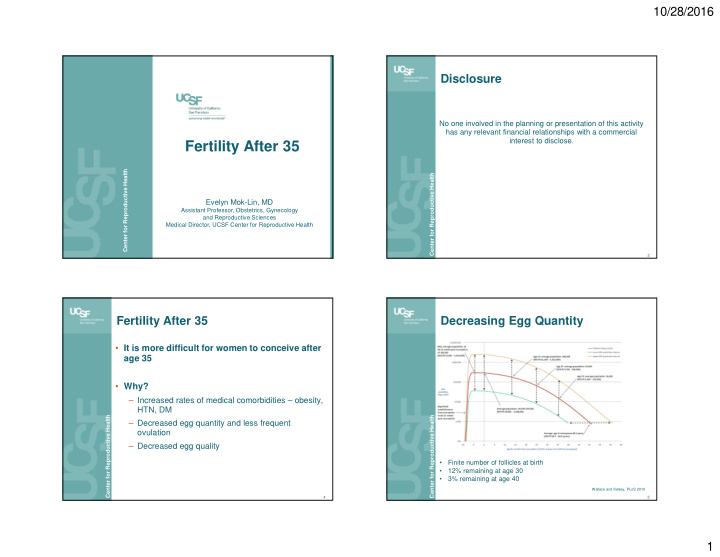



10/28/2016 Disclosure No one involved in the planning or presentation of this activity has any relevant financial relationships with a commercial Fertility After 35 interest to disclose . Center for Reproductive Health Center for Reproductive Health Evelyn Mok-Lin, MD Assistant Professor, Obstetrics, Gynecology and Reproductive Sciences Medical Director, UCSF Center for Reproductive Health 2 Decreasing Egg Quantity Fertility After 35 • It is more difficult for women to conceive after age 35 • Why? – Increased rates of medical comorbidities – obesity, HTN, DM Center for Reproductive Health Center for Reproductive Health – Decreased egg quantity and less frequent ovulation – Decreased egg quality • Finite number of follicles at birth • 12% remaining at age 30 • 3% remaining at age 40 Wallace and Kelsey, PLoS 2010 4 5 1
10/28/2016 Decreasing Egg Quality Abnormal Spindles in Older Eggs 20-25 year old eggs – 17% of eggs with abnormal spindle assembly 40-45 year old eggs Center for Reproductive Health – 83% of eggs with abnormal spindle assembly Heffner, NEJM 2004 Battaglia et al, Human Reproduction 1996 6 7 Increasing Rates of Chromosomal Aneuploidy Rates in Couples Abnormalities Undergoing IVF Franasiak et al. Fertility and Sterility 2014 8 9 2
10/28/2016 Age at which to start trying to What to do in women >35 who conceive desire to conceive • Preconception counseling – Prenatal vitamins – Modifiable lifestyle factors – Timed intercourse: menstrual tracking, use of ovulation predictor kits (OPKs) • Preconception testing Center for Reproductive Health • Initiate fertility evaluation in women over 35 if after trying to conceive for >6 months – >3 months in women over 40 Habbema et al. Human Reproduction 2015 10 11 Treatment Options Clomiphene Citrate (Clomid) • Superovulation • Selective Estrogen Receptor Modulator – Ovulation of >1 egg to overcome the age effect (SERM) – Oral agents (Clomid, Letrozole) • ER antagonist at the hypothalamus – Injectable FSH/LH (Gonal-F, Follistim, Menopur) • Inhibits negative – Often used in conjunction with intrauterine feedback of insemination (IUI) Center for Reproductive Health Center for Reproductive Health estrogen • Increased GnRH pulsatility • Increased pituitary FSH and LH secretion 12 13 3
10/28/2016 Clomid Instructions Potential Side Effects of Clomid Based on a 28 day cycle Take 50-150mg (1-3 tabs) daily x 5 days • Increased multiple pregnancy rate (7%) Start on cycle day 3 (days 3-7) • Mood swings • Hot flushes • Headaches • Bloating Check ovulation kit Center for Reproductive Health Center for Reproductive Health • Visual symptoms and light sensitivity Ultrasound on day 10 starting day 10 until + • Decreased endometrial thickness hCG trigger • Decreased cervical mucus Intercourse or IUI 12-24 Intercourse or IUI 24-36 hours after +kit hours after hCG trigger 14 15 Artificial Insemination (AI) or Letrozole (Femara) Intrauterine Insemination (IUI) • Aromatase inhibitor (AI) • Blocks conversion of androgens into estrogen • Inhibits negative feedback of Center for Reproductive Health Center for Reproductive Health estrogen • Increased GnRH pulsatility • Increased pituitary FSH and LH secretion 16 17 4
10/28/2016 Letrozole (Femara) • 2.5-7.5mg (1-3 tabs) daily x 5 days • Not FDA approved for fertility use • More expensive • Fewer side effects (fatigue and dizziness) • Increased success rates in PCOS patients Center for Reproductive Health Center for Reproductive Health – Legro et al., NEJM 2014 – 750 infertile women 18-40 years of age – Randomized to Letrozole or Clomid with intercourse for up to 5 cycles – Higher ovulation, pregnancy and live-birth rates in Letrozole group 18 19 IVF IVF Procedure Egg Retrieval FSH+LH 1 3 5 7 9 11 13 Days Center for Reproductive Health Center for Reproductive Health hCG trigger Veeck, Atlas of Human Gametes and Conceptuses 20 21 5
10/28/2016 Intracytoplasmic Sperm Injection IVF Procedure (ICSI) Center for Reproductive Health Center for Reproductive Health 22 23 Preimplantation Genetic Screening Preimplantation Genetic Screening • Risks of PGS: • PGS vs PGD – Increased cost • Benefits of PGS for women > 37: – Increased manipulation of the embryo – Decreased risk of early miscarriages – Decreased total number of embryos for transfer – Decreased risk of genetically abnormal pregnancies (possible decrease in cumulative pregnancy rate) – Decreased number of embryo transfer attempts Center for Reproductive Health Center for Reproductive Health – Error rates and mosaicism – Decreased risk of multiple gestation 24 25 6
10/28/2016 Summary • Fertility rates decrease and miscarriage rates increase more steeply >35 years of age Thank you • Offer preconception counseling and testing • Initiate infertility evaluation and refer to REI if a woman > 35 has been trying to conceive for 3-6 Center for Reproductive Health months • Treatment options include superovulation / IUI vs IVF (+/- PGS) 26 7
Recommend
More recommend